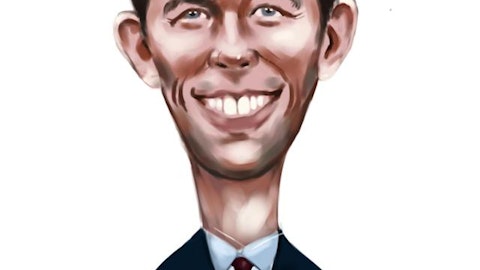Dominic Phillips: Yeah. Hey, Alex. So, again, I think that our business is holding up really well. We’re really pleased with the Q3 results. When we look at our customer demand, the overall pipeline, the conversion rates, the win rates, all of those remain strong. Obviously, we’re pleased with the Q3 results. We were able to increase our guidance for Q4 and for full-year FY 2023. And so, we’re seeing good strength. We’re not seeing it deteriorate. And I think a big reason that we’re seeing good momentum is because as we outlined in some of the case studies, we have really fast ROI. Customers are getting paid back within months. And we’re €“ they’re using our solution to find real hard ROI savings. They’re able to reduce their operational expenses. And then in this environment, you know that that often can get prioritized.
Alex Zukin: Got it. And then for my second question, it will be a bit of a smart ask question, but given the fact that you called out consensus estimates, as a ruler for next year, kind of being in the right range from a risk or de-risk perspective, I guess, I want to question whether the consensus estimates around margins are also the right way to think about de-risking, and then particularly in the context of your comments about, you know the Rule of 40?
Dominic Phillips: Yeah. I would just say, look, we want to get through Q4. We want to see what are results are. We want to finalize our FY 2024 operating plan, and then we’ll come back in three months, and we will give more detailed guidance across top line and margins, but I think you’ve seen our performance. We improved adjusted free cash flow margin by more than 75% over the last year. This is a really big focus for us. We’re really proud of the fact that we got to Rule of 40 in Q3. We need to be able to make improvements to sustain that. But, you know, you can expect us to continue to make improvements on that as we go into FY 2024 as well.
Alex Zukin: Perfect. Congrats, guys.
Dominic Phillips: Thank you.
Mike Chang: All right. Our next question comes from Matt Pfau at William Blair followed by Kirk Materne at Evercore.
Matt Pfau: Yeah, great. Thanks for taking my questions everyone. Appreciate it. Just two, both related, so I’ll ask them at the same time. First of all, if we look at the operating efficiencies that you’re achieving, maybe you can just help us understand where exactly those are coming from? And specifically, are there any change to hiring plans that are driving those? And then as we look at the margin guidance for the fourth quarter, it implies operating margin worse than Q3, maybe you can just help us understand what’s behind the guidance there for Q4? Thanks.
Dominic Phillips: Yes. Hey, Matt. So, it’s Dominic. Again, so on €“ when we think about, kind of our operating margin improvement for the quarter, obviously, we had some outperformance in revenue, which definitely helped us, we had some savings around gross margin came in a little bit better than expected. And then within our operating expenses really across the board we’re focused on just over operating efficiency improvements, but also some non-personnel related spend. So, can we get, you know, can we find software spend that we’re not utilizing? Can we think about how, you know, our unused real estate? Can we think about being more thrifty around things like T&E and events? And so, those are all areas of focus and projects that we’ve built to drive some of the operating efficiency improvements that you’ve seen.
In terms of the Q4 guide, I would really just focus investors on the full-year guide versus the kind of seasonality between Q3 and Q4. And so, overall operating margin for the year was negative 18% previously, now it’s negative 14%. We are basically passing through the $14 million of Q3 plus another $6 million for Q4. So, I would really focus investors on the full FY 2023 guidance versus the kind of Q3 versus Q4 seasonality.
Matt Pfau: Perfect. Appreciate it.
Mike Chang: Our next question comes from Kirk Materne at Evercore Materne followed by Derrick Wood at Cowen.
Peter Burkly: Hi guys. This is actually Peter Burkly for Kirk. Appreciate taking the questions here. So, just to start, you know, you guys are delivering pretty strong NRR rates. I’m just curious how you kind of characterize the balance between, you know, customers starting to go deeper with some of your more ancillary products versus, you know, just as these customers grow and they’re adding new vehicles, you know, adding the safety and telematics solutions there? You know, I mean, I would assume a customer adds new vehicles. And if they’re using you for safety, you know, that that’s just automatic addition right there, you know, just kind of naturally, but just curious, you know kind of how much those ancillary products are driving that, if at all?
Sanjit Biswas: This is Sanjit, by the way. So, it’s really a mix. We see customers adding additional assets to the platform as they continue to expand their operations and additional applications. So, quite often will land with two or more applications, but in many cases, some of these customers, if they’re larger, especially, they have a single project that they start with, might be telematics, or video-based safety or maybe even equipment monitoring. And then from there, once they get familiar with the platform, they see how much value in ROI it drives. They want to expand us, kind of across their entire operation. So, I would say it’s a pretty healthy mix between those two cases of expanding the number of seats or assets on the platform, as well as expanding applications with us.



